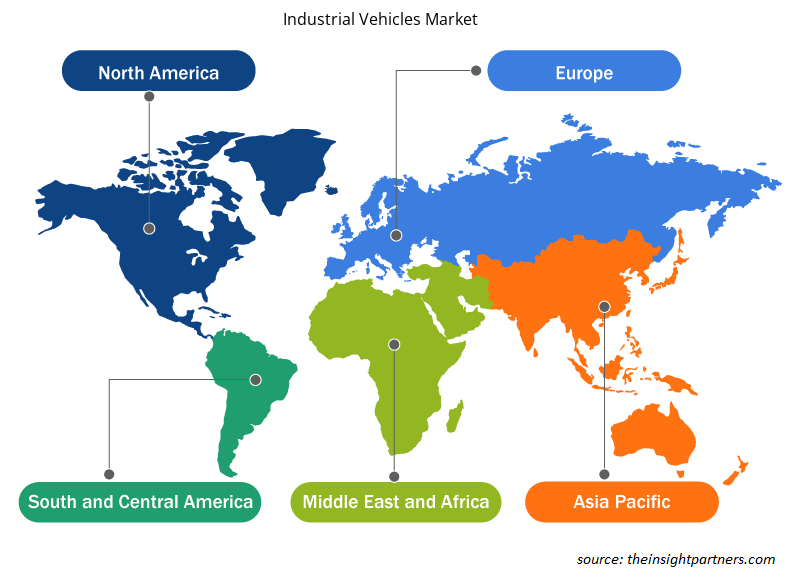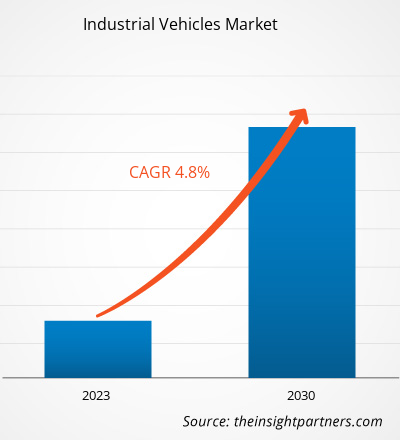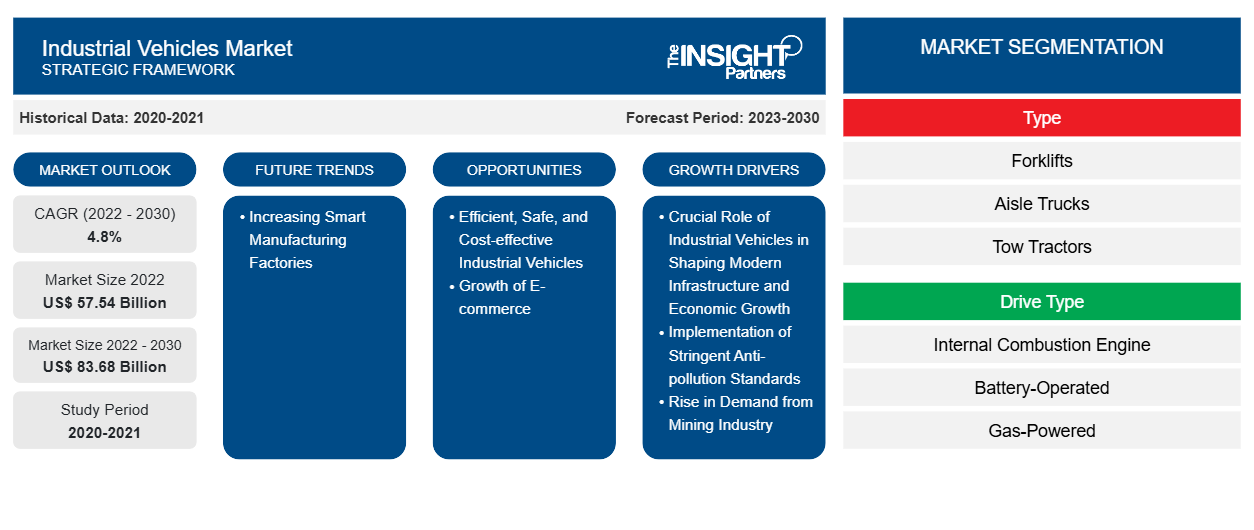[연구보고서] 산업용 차량 시장은 2022년에 57,543.40백만 달러 규모로 평가되었으며, 2030년까지 83,677.60백만 달러에 도달할 것으로 예상되며, 2022년부터 2030년까지 연평균 성장률 4.8%를 기록할 것으로 예상됩니다.
분석가 관점:
이 보고서에는 북미, 유럽, 아시아 태평양(APAC), 중동 및 아프리카(MEA), 남미(SAM)의 5개 주요 지역별 글로벌 산업용 차량 시장 전망이 포함되어 있습니다. 글로벌 전자상거래 산업은 꾸준한 속도로 성장하고 있으며, 이로 인해 기업들은 여러 물류 처리 차량의 도움으로 창고를 자동화하게 되었습니다. 전자상거래 산업은 지게차 및 기타 물류 처리 장비에 대한 수요 증가에 크게 기여하고 있습니다. 유엔 무역 개발 회의(UNCTAD)에 따르면 2022년 글로벌 전자상거래 산업의 소매 판매는 5조 9,000억 달러에 도달하여 2021년 대비 9.26% 증가했습니다. 2022년 개인당 평균 전자상거래 지출은 약 737.51달러였습니다. 중국은 전 세계에서 가장 큰 전자상거래 시장을 보유하고 있습니다. 2022년 중국의 전자상거래 매출은 1조 3,000억 달러에 달했으며 2025년까지 2조 달러에 도달할 것으로 예상됩니다. 따라서 전자상거래 부문의 확장은 아시아 태평양 지역의 산업용 차량 시장 성장을 위한 엄청난 기회를 창출했습니다.
세계산업차량통계협회(WITS)에 따르면 2021년에 234만 대 이상의 물류 차량 및 장비 판매가 기록되었습니다. 물류 산업은 2020년 대비 2021년에 주문이 43.0% 증가했습니다. 234만 대의 물류 유닛 중 약 68.8% 또는 161만 대가 전기 구동 지게차로 기록되었습니다. 전기 지게차 수요는 소비자 인기의 급증과 함께 빠른 속도로 증가하고 있습니다. 주문 수가 급증함에 따라 지게차, 통로 트럭, 팔레트 트럭과 같은 산업용 차량에 대한 수요가 증가했습니다. 따라서 제조 부문 전반에 걸쳐 전 세계적으로 물류 장비 및 차량에 대한 수요가 증가하면서 글로벌 산업용 차량 시장이 성장하고 있습니다.
북미 산업용 차량 시장 규모를 뒷받침하는 주요 요인에는 물류 및 운송, 전자 상거래 산업의 확장이 포함됩니다. 최근 몇 년 동안 미국에서 온라인 쇼핑이 증가했습니다. 총 미국 전자 상거래 매출은 2022년에 1조 300억 달러에 도달하여 2018년의 5,185억 달러에서 증가했습니다. UPS, FedEx, USPS, XPO Logistics, Amazon과 같은 시장의 많은 물류 거대 기업은 창고에서 산업용 차량에 대한 수요가 증가하고 있음을 인식했습니다. 이러한 회사는 창고 설립과 물류 운영 자동화에 상당한 투자를 했습니다. 예를 들어, 2023년 11월, United Parcel Service는 켄터키주 루이빌에 약 20에이커 규모의 가장 큰 창고를 열었습니다. 이 창고는 보관 및 패키지 처리를 위해 만들어졌으며 3,000대 이상의 자동화 로봇과 산업용 차량을 설립하기 위해 7,900만 달러의 상당한 투자가 이루어졌습니다. 이러한 로봇과 산업용 차량은 수동 노동 필요성을 줄여, 상품을 한 장소에서 다른 장소로 들어올리고 운반하는 등 여러 가지 창고 작업을 처리할 것입니다.
시장 개요:
산업용 차량 시장은 다양한 산업용 애플리케이션에서 사용하도록 설계된 다양한 범위의 특수 차량을 포함합니다. 이러한 차량은 산업 환경에서 특정 작업을 수행하도록 설계되어 다양한 부문에서 운영의 효율성, 생산성 및 안전성에 기여합니다. 이 시장은 제조 시설, 창고, 건설 현장, 물류 운영 및 기타 산업 환경의 특정 요구 사항을 충족하도록 특별히 설계된 광범위한 산업용 차량 으로 구성됩니다. 산업용 차량은 또한 특정 산업 과제를 해결하는 데 중점을 두고 설계되었습니다. 여기에는 자재 취급, 중량물 들어올리기, 물품 운송, 굴착 및 산업 공정에 필수적인 기타 특수 기능과 같은 작업에 최적화된 차량이 포함됩니다.
산업용 차량 시장은 기술과 혁신의 발전을 목격하고 있으며, 제조업체는 지게차와 같은 차량의 성능과 특징을 끊임없이 개선하고 있습니다. 진화하는 산업 요구 사항과 기술 발전에 대한 이러한 적응성은 산업용 이동성을 위한 보다 효율적이고 진보된 솔루션을 추구하는 기업을 유치하여 시장을 강화할 수 있습니다. 다양한 국가의 정부가 유럽에서 제조업을 자동화하는 데 투자하고 있습니다. 예를 들어, 2021년 7월 영국 정부는 디지털 제조 기술 개발을 촉진하기 위해 5,930만 달러(5,300만 파운드)를 투자한다고 발표했습니다. 그 중 2,810만 달러(2,500만 파운드)는 제조 사업을 혁신하기 위해 최첨단 디지털 솔루션 개발을 지원하는 5개의 새로운 산업 지원 연구 센터를 설립하는 데 투자될 예정입니다. 나머지 금액은 디지털 공급망 혁신 허브에 투자되어 제조 공급망을 디지털화하고 혁신하기 위한 37개 개별 프로젝트에 제공될 예정입니다. 따라서 자동화를 촉진하기 위한 정부 지원이 확대됨에 따라 예측 기간 동안 산업용 차량 시장 성장이 촉진될 것으로 예상됩니다.
귀하의 요구 사항에 맞게 이 보고서를 사용자 정의하세요
이 보고서의 일부 또는 국가 수준 분석, Excel 데이터 팩을 포함하여 모든 보고서에 대한 사용자 정의를 무료로 받을 수 있으며 신생 기업 및 대학을 위한 훌륭한 혜택과 할인 혜택을 이용할 수 있습니다.
-
이 보고서의 주요 시장 동향을 알아보세요.이 무료 샘플에는 시장 동향부터 추정 및 예측까지 다양한 데이터 분석이 포함됩니다.
시장 동인:
엄격한 공해 방지 기준의 구현으로 산업용 차량 시장이 활성화됩니다.
유럽(5단계) 및 북미(4단계 최종)와 같은 엄격한 오염 방지 표준이 전 세계의 산업용 차량에 시행되고 있습니다. 2019년 1월 1일에 도입된 이러한 표준은 농업, 건설 현장 및 산업 현장에서 사용되는 차량을 포함하여 비도로 차량에서 발생하는 질소 산화물(NOx) 및 입자 오염 물질 배출에 대한 추가 제한을 부과합니다. 이러한 규정의 원동력은 공중 보건 문제를 해결하고, 대기 질을 개선하고, 차량 배출이 기후 변화에 미치는 영향을 완화해야 하는 시급한 필요성입니다. 이러한 환경적 과제에 대한 주목할 만한 대응책 중 하나는 산업용 차량의 가속화된 전기화입니다. 전기화로의 이러한 전환은 이러한 엄격한 표준에서 설정한 배출 목표를 충족해야 하는 필수성에 의해 주도됩니다. 굴삭기, 이동식 크레인 , 굴삭기 및 불도저를 포함하여 건설 산업에서 다양한 현장 차량과 트랙터 및 콤바인 수확기와 같은 농업 차량이 사용되는 경우 전기 및 하이브리드 대안이 점점 더 선호됩니다.
전기 및 하이브리드 산업용 차량은 제조업체와 운영자가 엄격한 배출 기준을 준수하는 데 도움이 됩니다. 이러한 차량은 유럽의 Stage V 및 북미의 Tier 4 Final에서 설정한 규정에 맞춰 NOx 및 입자 오염 물질 수준을 상당히 낮춥니다. 산업용 차량에서 발생하는 유해 배출물의 감소는 대기 질 개선에 기여하여 공중 보건에 긍정적인 영향을 미칩니다. 도시화가 계속 확대됨에 따라 인구 밀도가 높은 지역에서 차량 배출물의 영향을 완화하기 위해 더 깨끗하고 지속 가능한 산업용 차량의 배치가 중요해지고 있습니다. 또한 환경 문제에 대한 인식이 높아지고 지속 가능성에 대한 강조가 커지면서 더 깨끗하고 효율적인 산업용 차량에 대한 수요가 증가하고 있습니다. 환경 친화적 관행을 우선시하고 배출 기준을 준수하는 회사는 더 광범위한 고객 기반을 유치하고 장기적인 시장 생존 가능성을 확보할 가능성이 높습니다. 전기 및 하이브리드 대안으로의 전환은 규정 준수를 보장할 뿐만 아니라 대기 질 개선, 기후 변화 해결, 지속 가능한 관행에 대한 소비자 선호도 충족이라는 더 광범위한 목표와도 일치합니다. 따라서 산업용 차량과 관련된 엄격한 오염 방지 표준의 구현이 시장을 주도합니다.
세그먼트 분석:
차량 유형에 따라 산업용 차량 시장 분석은 포크리프트, 통로 트럭, 견인 트랙터, 컨테이너 핸들러 및 기타(펠릿 트럭, 리치 트럭, 오더 피커 및 스태커) 세그먼트를 고려하여 수행되었습니다. 이 중 포크리프트 세그먼트는 물류 및 운송 부문의 빠른 성장으로 인해 산업용 차량 시장 점유율을 지배합니다. Global Logistics Association에 따르면 2021년 글로벌 물류 산업의 가치는 8조 6,000억 달러였으며 2027년까지 135억 달러에 도달할 것으로 예상됩니다. 2021년에 글로벌 물류 산업의 약 45%가 아시아 태평양에 집중되었습니다. 또한 북미 물류 산업의 점유율은 2020년에 전 세계적으로 약 24%였고 그 다음은 유럽이었습니다. 아시아 태평양은 전자 상거래 산업 매출이 증가함에 따라 산업용 차량 시장에서 가장 빠르게 성장하는 지역입니다. 2022년 아시아 태평양 지역에서 물류 부문 지출은 약 4조 9,000억 달러에 달했으며 2022년부터 2027년까지 연평균 성장률 5.9%를 기록할 것으로 예상됩니다. 중국은 아시아 태평양 지역에서 가장 큰 점유율을 차지하며 물류 부문 지출의 54.1%를 차지합니다. 이는 주로 제조 및 자동차 부문의 경제 성장 때문입니다. 산업용 차량은 유리한 정부 정책과 지역 무역 이니셔티브로 인해 전자 상거래 부문이 증가함에 따라 한 장소에서 다른 장소로의 자재 처리를 위해 물류 부문에서 널리 사용됩니다. 통로 트럭, 견인 트랙터, 컨테이너 핸들러, 팔레트 트럭, 리치 트럭, 오더 피커 및 스태커도 전 세계 전자 상거래 물류 산업에서 사용됩니다.
지역 분석:
산업용 차량 시장 보고서의 범위는 북미(미국, 캐나다, 멕시코), 유럽(스페인, 영국, 독일, 프랑스, 이탈리아, 유럽의 나머지 지역), 아시아 태평양(한국, 중국, 인도, 일본, 호주, 아시아 태평양의 나머지 지역), 중동 및 아프리카(남아프리카, 사우디 아라비아, UAE, 중동 및 아프리카의 나머지 지역), 남중부 아메리카(브라질, 아르헨티나, 남중부 아메리카의 나머지 지역)에 초점을 맞추고 있습니다.
수익 측면에서 아시아 태평양 지역이 산업용 차량 시장 점유율을 지배했습니다. 유럽은 글로벌 산업용 차량 시장에 두 번째로 큰 기여자이며, 그 다음은 북미입니다. 북미 산업용 차량 시장은 건물 및 건설 활동의 증가와 상용차 판매 증가에 의해 주도됩니다 . American Automotive Policy Council(AAPC) 보고서에 따르면 Fiat Chrysler Automobiles NV, Ford Motors, General Motors는 미국 시장에서 상용차 제조에 많은 투자를 하고 있습니다. 미국의 자동차 제조는 전 세계에서 8번째로 큰 경제이며 2021년에 약 2조 6,400억 달러의 가치를 추가했습니다. 자동차 및 그 부품 제조는 전체 제조업의 6%를 차지합니다. 자동차 부문은 매년 미국 경제에 1조 달러 이상을 기여하며, 이는 GDP의 4.9%를 차지합니다.
정부의 인프라 개발 투자를 포함한 증가하는 건물 및 건설 투자는 북미에서 산업용 차량에 대한 수요를 견인하고 있습니다. 예를 들어, 2021년 8월, 미국 교통부 및 인프라부는 앨버타주와 브리티시컬럼비아주 서부 캐나다 간 고속도로 확장 프로젝트에 약 8억 3,700만 달러를 투자했습니다. 이 프로젝트에는 교량 건설과 2차선에서 4차선 고속도로로 확장하는 작업이 포함됩니다. 건설 차량은 작업반이 여러 건설 활동을 빠르고 효율적으로 수행하는 데 도움이 됩니다. 이러한 차량은 다양한 건설 차량을 사용하여 돌이나 골재와 같은 건설 자재를 운반하기 위해 도랑을 파는 데 사용됩니다. 다양한 산업용 차량은 건설 현장에서 여러 기능을 수행하기 위해 특정 작업을 위해 설계되었습니다. 이러한 인프라 개발 프로젝트에는 지게차, 크레인, 도로 롤러, 덤프 트럭을 포함한 다양한 산업용 차량이 필요합니다. 따라서 자동차 산업은 북미의 여러 국가에서 건설 프로젝트가 증가함에 따라 확장되고 있으며, 이는 산업용 차량 시장을 견인합니다.
산업용 차량 시장 지역 통찰력
Insight Partners의 분석가들은 예측 기간 동안 산업용 차량 시장에 영향을 미치는 지역적 추세와 요인을 철저히 설명했습니다. 이 섹션에서는 북미, 유럽, 아시아 태평양, 중동 및 아프리카, 남미 및 중미의 산업용 차량 시장 세그먼트와 지리에 대해서도 설명합니다.

- 산업용 차량 시장에 대한 지역별 특정 데이터 얻기
산업용 차량 시장 보고서 범위
| 보고서 속성 | 세부 |
|---|---|
| 2022년 시장 규모 | 575억 4천만 달러 |
| 2030년까지 시장 규모 | 836억 8천만 달러 |
| 글로벌 CAGR (2022-2030) | 4.8% |
| 역사적 데이터 | 2020-2021 |
| 예측 기간 | 2023-2030 |
| 다루는 세그먼트 |
유형별로
|
| 포함된 지역 및 국가 |
북아메리카
|
| 시장 선도 기업 및 주요 회사 프로필 |
|
산업용 차량 시장 참여자 밀도: 비즈니스 역학에 미치는 영향 이해
산업용 차량 시장은 소비자 선호도의 변화, 기술 발전, 제품의 이점에 대한 인식 증가와 같은 요인으로 인해 최종 사용자 수요가 증가함에 따라 빠르게 성장하고 있습니다. 수요가 증가함에 따라 기업은 제품을 확장하고, 소비자의 요구를 충족하기 위해 혁신하고, 새로운 트렌드를 활용하여 시장 성장을 더욱 촉진하고 있습니다.
시장 참여자 밀도는 특정 시장이나 산업 내에서 운영되는 회사나 기업의 분포를 말합니다. 주어진 시장 공간에 얼마나 많은 경쟁자(시장 참여자)가 존재하는지 그 규모나 총 시장 가치에 비해 나타냅니다.
산업용 차량 시장에서 운영되는 주요 회사는 다음과 같습니다.
- 키온 그룹 AG
- 도요타 산업 주식회사
- 미쓰비시 중공업 주식회사
- 코마츠 리미티드
- 코네크레인
면책 조항 : 위에 나열된 회사는 어떤 특별한 순서에 따라 순위가 매겨지지 않았습니다.

- 산업용 차량 시장의 주요 업체 개요를 알아보세요
주요 플레이어 분석:
KION Group AG, Toyota Industries Corporation, MITSUBISHI HEAVY INDUSTRIES, LTD., Komatsu Limited, Konecranes, Anhui Heli Co., Ltd., Hyster-Yale Materials Handling, Inc., Jungheinrich AG, Crown Equipment Corporation, Clark Material Handling Company는 이 보고서에서 다루는 주요 기업 중 일부입니다.산업용 차량 시장 보고서. 이 보고서는 현재 산업용 차량 시장 동향과 시장에 영향을 미치는 추진 요인에 따른 성장 전망을 포함합니다.
최근 개발 사항:
합병 및 인수와 같은 무기적 및 유기적 전략은 산업용 차량 시장의 회사에서 널리 채택됩니다. 시장 이니셔티브는 회사가 전 세계적으로 입지를 확장하고 증가하는 고객 수요를 충족하기 위해 채택한 전략입니다. 시장에 있는 시장 참여자는 주로 고급 기능과 기술을 제품에 통합하여 제품 및 서비스 개선에 중점을 두고 있습니다. 주요 산업용 차량 시장 참여자의 최근 개발 사항은 다음과 같습니다.
년도 |
소식 |
국가 |
|
2023년 9월 |
Jungheinrich와 Mitsubishi Logisnext Americas는 협력하여 Rocrich AGV Solutions를 출시했습니다. 이 솔루션을 통해 회사는 북미 시장의 창고 및 생산 시설에 대한 자동화 솔루션을 제공하는 것을 목표로 합니다. |
북아메리카 |
|
7월-2023 |
인도 최대의 알루미늄 제조업체인 Vedanta Aluminium은 전기 리튬 이온 지게차 함대를 늘려 인도 최대의 함대를 만들었습니다. Vedanta Aluminium은 오디샤와 차티스가르에서 44대의 차량을 운영함으로써 지속 가능성에 대한 의지를 보여줍니다. |
아시아 태평양 |
- 과거 분석(2년), 기준 연도, CAGR을 포함한 예측(7년)
- PEST 및 SWOT 분석
- 시장 규모 가치/거래량 - 글로벌, 지역, 국가
- 산업 및 경쟁 환경
- Excel 데이터세트
최근 보고서
사용 후기
구매 이유
- 정보에 기반한 의사 결정
- 시장 역학 이해
- 경쟁 분석
- 고객 인사이트
- 시장 예측
- 위험 완화
- 전략 기획
- 투자 타당성 분석
- 신흥 시장 파악
- 마케팅 전략 강화
- 운영 효율성 향상
- 규제 동향에 발맞춰 대응























 무료 샘플 받기 - 산업용 차량 시장
무료 샘플 받기 - 산업용 차량 시장